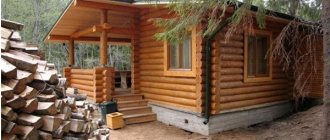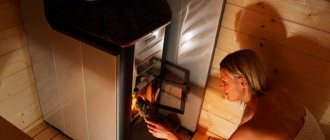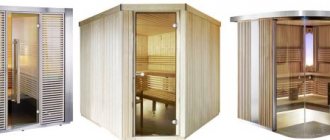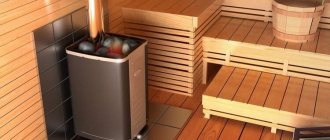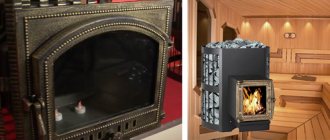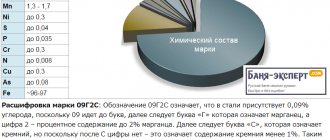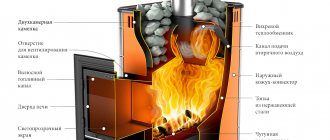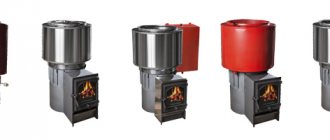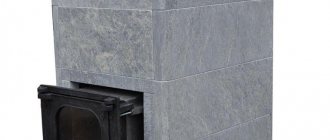This may seem elementary, but laying stones in an electric heater has certain features that any stove owner should know. Mostly, owners simply take the first material they come across, laying it out as they see fit. However, then the steam room does not fulfill its purpose properly.
If unsuitable rocks are used for this, they may crumble after the first fire. A split is possible, after which the heater will smoke heavily. This can seriously ruin your time in the steam room. To avoid such consequences, you need to find out how to place stones in an electric heater, and what types of stones are most suitable.
How many stones should I put?
You can calculate how many kg of stones you need in a sauna stove yourself; let’s try to do this using a simple example.
So, for example, let’s take the original data:
- The volume of the steam room (excluding the stove) is 15 m3 - quite large.
- We use basalt stone.
- Creating steam every hour 3 times, at the rate of 70 ml/m3, then the stove consumes 0.07x15x3= 3.15 liters of water/hour.
- The operating time of the bath is 5 hours.
- The initial temperature of the stones (measured at a depth of 9-13 cm) is 500 degrees.
- The final heater temperature at which steam can still be produced is 150.
- The temperature of saturated steam from the heater is 110 degrees.
- The temperature of the supplied water is 80 degrees.
Now the calculations:
- The total amount of water poured onto the heater in 5 hours is 4.5 x 5 = 15.75 liters.
- To adjust water from 80 to 100 degrees you need: W1=15.75x1x(100-80)=315 kcal
- In order for this water to become steam: W2=15.75×538=8473.5 kcal
- Next, to heat the steam to 110 degrees: W3 = 15.75 × 0.48 × 10 = 75.6 kcal
- So, all you need is: W1+W2+W3 =8864.1 kcal
- 1 kg of stone, cooling from 500 to 150 degrees, releases heat: W4=C*(Tt)=0.15(500-150)= 52.5 kcal
- Total stones required: P = 8864.1/52.5 = 168.84 kg.
Again, this is conditional data; in reality, everything may differ. But now you know that approximately 1m3 of steam room volume (excluding the stove) accounts for 11 kg of stones.
"Vesuvius" with open or closed heater: the choice is yours
Since the structure for laying stones is located outside, it should be understood that it is unable to provide steam with the humidity that the very concept of “Russian bath” in its classical interpretation implies. If you are a fan of a real Russian steam room, with its inherent humidity and high temperature, then consider purchasing models that have a closed heater. If you love the specifics of the Russian bathhouse, but you are still attracted by the appearance of an open heater, the appearance of the stones laid in it, then you will have to acquire additional devices and fixtures, examples of which we will describe below.
According to experts, in an open-type heater there are no conditions for the stones to heat up to a temperature level that would make the steam really light. If the furnace power is high enough, it provides good heating of the stones. However, since the stones are open, they quickly release their heat into the steam room. This state of affairs makes the bathhouse more similar not to a Russian, but to a Finnish dry-air sauna.
It is easy to pour water onto stones placed in an open heater, but the resulting steam turns out to be “heavy”. To provide the couple with the desired “lightness,” bath professionals lay tubes between the stones that go deep into the stone mass, and through them water or herbal infusions are supplied. Since the temperature of the stones located near the firebox is much higher, the steam they produce is drier. Rising through the layer of stones laid on top, the steam is additionally dried and becomes finely dispersed, i.e. it turns into that “light” steam that is typical for a Russian bath.
However, this improvement of the heater using tubes is far from ideal: a heated stove does not allow you to calmly strain water into the tubes laid for this purpose, and there is a high risk of getting burned by the escaping clouds of steam. The matter is complicated by the fact that initially the tubes are laid purely intuitively. If the laying result is unsatisfactory, the stones have to be re-laid in order to move the tubes inserted into their mass. Thus, this improvement can only result in additional hassle for those who like to steam.
In our opinion, stove models with a closed heater are the most suitable option for steam rooms, called Russian. However, greater convenience of their use is achieved provided that the open part of the heater can be closed and covered, which ensures regulation of heat transfer and heating of the stones themselves.
Is it possible to mix stones for a bath?
When placing stones in a sauna stove, place different types, you do not harm either the heater or the air. On the contrary, mixing is used for aesthetic, medicinal, and technical purposes.
Stones are mixed to save money, due to the impossibility of filling the kiln completely with expensive stones. They can be laid either scattered or in layers; one option is to place faster-heating types on the bottom so that heating occurs more easily.
An equally important part of the steam room is aesthetic pleasure; beautifully arranged rocks of different colors, black shades and red, gray and green, will amuse the users of the bath.
Vesuvius brand water tanks for sauna stoves
The basic equipment used in Vesuvius stoves does not include water tanks. However, you can freely purchase a water tank of the same brand that suits you.
Rectangular tanks are available for sale, both pipe-mounted (55-80 l) and hinged (60-125 l). Millimeter matte stainless steel is used for their manufacture. The G3/4 fittings are located on the sides of the tank or on its bottom.
| Rectangular tank on a pipe | Mounted oval tank | Oval tank for pipe |
Oval contour-type tanks of vertical or horizontal placement (60, 90 l), oval-shaped pipe tanks are made of mirror stainless steel 0.5-1.0 mm. The tanks are equipped with filling holes and G3/4 fittings.
In addition, Litcom also offers heat exchangers that can be round or flat (6, 12 l). They are made of stainless steel 0.5-1.0 mm and have G3/4 fitting connections.
Choosing the shape and size of stones
Placing stones in the sauna stove of the correct size and shape is the key to good and light steam. The shape affects the amount of water retained.
The ideal would be to choose a tumbled or chipped form. The chipped ones are quite large in area, the minus is strength, frequent cracks and breakages. Galvanized ones are the most durable, tumbling eliminates fragile samples, the area is not inferior to crushed cobblestones, the minus is the high cost. Do not buy smooth, polished cobblestones; the “moisture retention” parameter suffers extremely.
The size is divided into three fractions, small, normal and large. 5-12 centimeters is a suitable size. According to the rules, large fractions are placed on the bottom layer, then normal and small ones on top.
Model ranges of Vesuvius stoves
Among those where an open heater is installed, the most spectacular and unusual are the models of the Vesuvius Vertical series. The external dimensions of all modifications are the same (WxDxH = 540x790x1010 mm), the difference lies in the design of the door covering the combustion tunnel. Some doors have panoramic glass or regular heat-resistant glass, others have no glass at all. This line, the cost of various models of which ranges from 12 to 20 thousand rubles, is capable of heating steam rooms with a volume of 8-18 m3.
Furnace Vesuvius-Vertical
"Vesuvius-Vertical"
The “Vesuvius Skif” and “Russian Steam” lines also have an open heater, which are distinguished by a wide variety of sizes and door designs. Thus, “Russian Steam” has six modifications that are capable of heating steam rooms ranging in size from 18 to 23 m3 and the average cost of which is in the range from 24 to 27 thousand rubles.
Furnace Vesuvius Skif
"Vesuvius Scythian", model SCH12
“Scythians” have 26 options that are capable of heating rooms of almost any size and which are distinguished by a wide variety of designs for the doors of the combustion portal. With an abundance of options, the price range is also wide - from 10 to 25 thousand.
Vesuvius Elite stove
"Vesuvius Elite", lined with coil
In Vesuvius Elite stoves, which attract attention with their appearance, their own coil plays the role of lining. The combustion tunnel door of these stoves is decorated with built-in glass. There are relatively few modifications in this series, and their prices start at 40 thousand rubles.
Vesuvius Lava Furnace
Sauna stove Vesuvius Lava
The line with a closed heater is represented by the popular Vesuvius Lava stove, the distinctive feature of which is the forged decorative linings that decorate the body. This series has a large number of modifications (currently there are 24), differing in power, overall dimensions, the presence or absence of a fuel tunnel, door glazing or its absence. Buyers can choose from this series such sauna stoves that are capable of heating steam rooms measuring 6-28 m3. The abundance of models also implies a wide range of prices, which range from 12 to 28 thousand rubles.
Furnace Vesuvius Rusich
"Vesuvius Rusich"
Sauna stoves "Vesuvius Rusich" are produced without forged elements on the surface of the body, but this does not matter for those bath lovers who intend to surround the stove with a brick screen, which improves the quality of the steam, which more fully meets the requirements of the Russian steam room. The price of the product is 16-18 thousand rubles.
Furnace Vesuvius Legend
Sauna stove Vesuvius Legend
The “Legend” line, made of cast iron, has a fairly significant weight (about 160 kg), has an open-type heater and a combustion tunnel. Such sauna stoves are capable of heating steam rooms measuring 10-28 m3. Various models cost from 14 to 23 thousand.
The advantages of Legend stoves are described in detail in the video we offer.
Video – Sauna stove Vesuvius Legend
Each line includes fireplace stoves equipped with doors with wide panoramic heat-resistant glass.
What stones should not be placed?
The following minerals are contraindicated for use:
- Granite.
- Quartz.
- Spar.
- Mica.
- Pyrite.
- Electroporcelain.
- Marble.
- Limestone.
- Flint.
Such minerals contain harmful elements such as sulfur, iron, and decay products of radionuclides that release radioactive gases.
Laying algorithm
Stone minerals have the characteristics of “thermal conductivity” and “heat capacity”. Baths are built “convection” or not, convection quickly warms up the air, preventing the heat from stagnating in the rocks.
This method will give a short-term fire. Proper placement of stones in a sauna stove will help warm up the stones, which will give off heat to the air for a long time, the steam will become lighter and the room will retain heat longer.
Using the instructions, you can achieve better heating of minerals in a short time:
- The correct placement of stones in a long-shaped sauna stove is not horizontal, but vertical, on its side. There are explanations for this; when warming up, gaps are needed through which heat passes for air circulation.
- You cannot stack stone blanks tightly; when heated, expansion occurs and tightly packed stones begin to break under each other’s pressure.
These actions prolong the performance of the filler and increase the rate of heating of the room.
The two types of ovens, open and closed, require different lining methods. Correct placement of stones in a sauna stove ensures heat accumulation and, therefore, good steam generation:
- Closed heaters are filled with filler according to the instructions and closed with a door; there are no questions about the amount of filler.
- Open stoves cause bewilderment, the question arises: “How high should I put it?” Stones are placed in the sauna stove up to the top of the walls; those that lie above the wall warm up worse.
How to lay stones in a stove
Bath procedures are not only pleasant, they can also be healing.
But for this it is necessary to choose the right raw materials with which the stove-heater is filled. However, what stones are suitable for a sauna heater and where to get them? We will answer these and many other questions in this article.
The photo shows stones for heaters in packages.
If we talk about a camp bath, then even river pebbles or ordinary cobblestones found at a vacation spot will do. For a stationary steam room, it is necessary to choose only high-quality stones, which are best purchased in specialized stores. (see also the article Features of sauna stoves with a closed heater).
Popular products for heater stoves
Minerals for such raw materials are harvested in certain conditions and places, and therefore they are not characterized by increased radioactivity and do not emit harmful substances.
Advice! Under no circumstances should you take stones from railway embankments, as they are treated with creosote.
This composition is poisonous.
Therefore, the safest approach to the matter is to purchase stones for the stove with a mark on the packaging that the product has passed radiation control.
It is better to purchase this product in specialized stores
Today, cast iron bath stones are very popular. And although they do not differ in any special healing effect on the body, they perfectly accumulate heat. (see also the article Stove stove for a Russian bath: how to make it yourself).
The following instructions will help you choose stones for your sauna heater.
Raw materials must meet the following criteria:
- Resistance to high temperatures. No matter what stones you use for your sauna, they should not chip or crack.
Advice! Checking the quality of stones is carried out as follows: either by hitting a hammer or tapping each other. A more serious check is done in the bathhouse: first heat the stones red-hot, and then throw them into cold water.
High-quality raw materials must withstand such a difference.
- Ability to accumulate heat. One of the most important characteristics of bath stones is the ability to heat up quickly and release heat for a long time. This ability is tested in this way: the stone for the heater in the bathhouse must have a high specific gravity, be dense and uniform in structure.
The ability to give off heat is one of the main characteristics of bath stones.
- Format. Each type of furnace requires a certain type of raw material. For those bath attendants who pay attention to this criterion, the stones last a surprisingly long time. There are two sizes of bath stones:
- Large ones (from 70 to 130 mm) are better suited for wood stoves.
- Small ones (50-60 mm) are usually used for modern electric furnaces, which, due to their compactness, simply do not allow the use of large-sized raw materials.
Advice! Judging by their size, salt stones are universal.
They come in both large and small, and have high technical characteristics.
- No harmful additives, as mentioned above. The fact is that at high temperatures typical of a bathhouse, even seemingly environmentally friendly materials begin to emit harmful substances. Therefore, this criterion is very important.
Sea and river pebbles.
Naturally, the main criterion when choosing any material for a domestic buyer is its price. However, if you want your self-created sauna to have the right microclimate, you should approach the choice of sauna stone very seriously. Let's look at some of the most interesting options.
Many bath attendants consider this option to be very, very acceptable, and besides, you can get the pebbles completely free of charge. Such stones are usually laid as the first layer, and soapstone is placed on top of them.
Jadeite stone
Some tips for choosing:
- Sea pebbles should not be ovoid-shaped, but slightly flattened - this way you will ensure greater packing density, which will virtually eliminate the possibility of accidental water getting into the metal.
- Pebbles with red veins or a reddish tint should be discarded. Red color indicates the release of iron, the oxides of which will be harmful when heated.
- You cannot take soft stones from the bottom, since limestone is not only very harmful, but is also prone to rapid destruction, forming soft, difficult-to-remove dust on surfaces.
Advice! If in your area there is neither a sea nor a river, then you can find good pebbles under power lines.
In Soviet times, high-voltage transmission lines were often covered with pebbles.
Gabbro-diabase
Gabbro-diabase.
Gabbro-diabase is of volcanic origin and is very similar to black marble. Its main characteristics are high strength and low water absorption. It is mined in Karelia and is considered an environmentally friendly raw material.
The disadvantage of gabbro-diabase is that it takes a long time to absorb heat, quickly cooling down when the fire dies out. When heated strongly, the stone can emit an unpleasant specific odor.
Some tips for use:
- Do not use essential oils with tinctures for these stones, as this will quickly cause carbon deposits to form on their surface.
- Carry out regular sorting and discard those copies that are unsuitable for further use. If you do not do this, sandy waste will clog the grates of your stove over time.
We invite you to familiarize yourself with the Heat exchanger for a chimney pipe for a bathhouse
Perhaps the most important advantage of gabbro-diabase is its low cost, which is several times lower than its analogues.
Soapstone chlorite
Soapstone chlorite.
Soapstone is an environmentally friendly rock that has greater density and durability than gabbro-diabase. Such stones are not very attractive, but at the same time they delight with their high heat capacity.
Characteristics:
- When heated, soapstone does not release any toxic impurities into the air.
- Some stones may become dusty. To avoid this, be sure to rinse and roll the raw materials well before first use.
- Soapstone is characterized by rapid heating. At the same time, it accumulates heat 2.5 times more than a brick and releases it for a long time and evenly.
- Hot stones emit pleasant and light steam.
Basalt
Basalt.
It is the strongest of all volcanic rocks used for baths. Its advantages: high heat capacity and extremely low moisture absorption. It tolerates high temperatures and temperature changes very well. Durable and environmentally friendly.
Hot basalt produces intense steam for quite a long time, and at the same time has a very reasonable cost.
Conclusion
Bathhouse, oven, heat - what could be more pleasant!
As you can see, the choice of bath stones today is quite large. (see also the article Features of sauna stove designs). By comparing the advantages and disadvantages of the options described above, you can choose the most acceptable one. Check out the video in this article for more information.
- How to choose stones?
- Laying stones in the bathhouse
A heater is a component of a sauna stove designed to produce steam. Externally, it looks like a container with stones laid out in it. When heated, they serve as evaporators, to which water is supplied during the vaping procedure.
It is well known that not all specimens lying on the shore are suitable for a heater; they must be selected carefully. The functioning and durability of the building also depends on how the stones are laid in the bathhouse.
That is why it is necessary to approach this stage of construction with particular seriousness.
How to choose stones?
The best and only correct answer to the question “where and how to choose stones for the heater in the sauna?” is – “in a specialized store.” Only there they can offer you several types of suitable materials. They are significantly different from natural ones. Elements of unknown origin can cause significant harm to health.
Since you cannot know their chemical and physical properties, it is not always safe. And when heated, as is known, they are activated with particular force. Any type of stone available in stores today, regardless of which one you choose, has a number of characteristics.
It is they who distinguish the rocks suitable for heaters from all others:
- Heat resistance - the ability of a product to withstand high temperature loads without collapsing or losing its properties
- Heat capacity is one of the most important indicators of bath stones, which determines their ability to retain heat in a room for as long as possible.
- Environmental Safety
- Non-toxic during heating process
- Low susceptibility to thermal expansion
The most common certified breeds today are:
- Soap chlorideThe complex of physical and chemical properties of this rock allows it to easily tolerate heating up to 16000C. The high density of the stone makes it possible to accumulate thermal energy, evenly distributing heat transfer.
- Gabbro-diabaseA rock of volcanic origin. Although it contains many minerals, none of them are harmful to human health. Despite the relatively low cost of this material, it has all the necessary properties, which allows it to be successfully used in a heater.
- Jadeite is a semi-precious stone. Physical and chemical characteristics allow it to be used in a bath. Possessing high strength and low levels of water absorption, the stone has a high degree of heat transfer. Jadeite is considered the most durable material for a bath or sauna.
- QuartziteA rock consisting of 90% quartz. Its main distinguishing feature is its ability to heat up quickly. In this regard, it is recommended to use quartzite in combination with other stones in the heater.
- PeridotiteA rock of igneous origin, containing olivine and pyroxene. It can easily withstand high temperature loads without emitting any substances harmful to human health, since there are no dangerous impurities in its composition.
- Chromite is a very heavy and dense natural material, due to which it is practically not subject to thermal expansion. The chromium contained in this rock is absolutely non-toxic.
- Basalt is one of the most durable among the “bath” stones, and accordingly it retains its integrity longer than others. The high heat capacity coefficient ensures long-lasting heat in the steam room.
Lifetime of stones
The service life of the filler depends on the breed and quality. Over the course of a year, there is a high chance that some stones will become unusable and will have to be replaced. Ideally, a complete replacement takes place every three to four years. This is due to the following factors:
- Pollution. Toxins and dirt accumulate on minerals.
- Wear. Most of the heat capacity is lost through cracks and fractures.
- Unpleasant appearance. Old things get boring, and going to the bathhouse brings less pleasure.
In order for wear to occur more slowly, you should avoid temperature changes, do not pour cold water on the stones and do not expose them to open fire. When placing stones in the heater, rinse them to remove dirt and avoid unpleasant odors.
